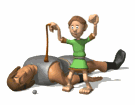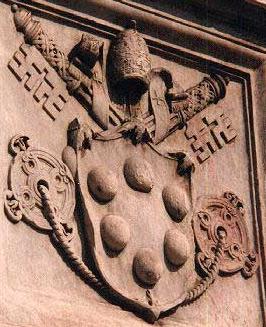

Santa Croce Church
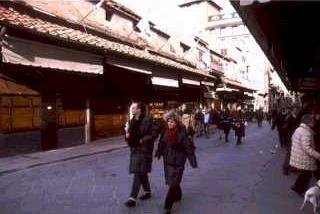
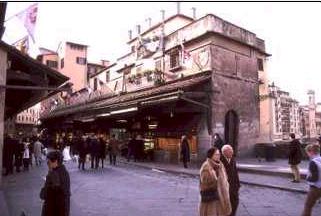
Shopping on the Old Bridge, Il Ponte Vecchio
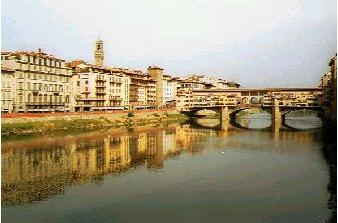
View of the Arno River and the Old Bridge
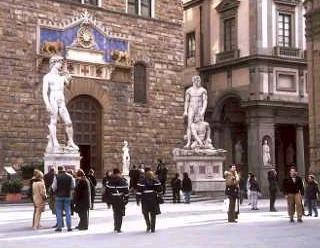
The Entrances to the Town Hall (l) and the Uffizi
Galleries (r) 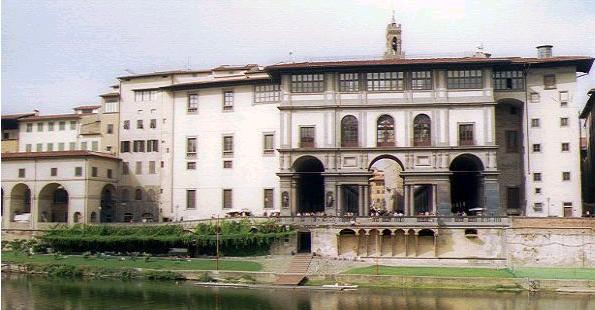
The Uffizi Galleries from Across the River,
Vasari's Corridor on the left above the Arches
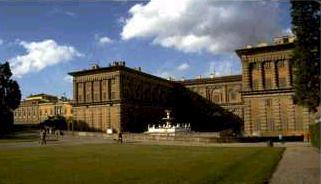
Pitti Palace from the Boboli Gardens

The Fountain of Neptune in the Boboli Gardens 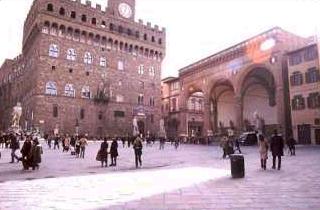
The Main Square, Piazza delle Signorie
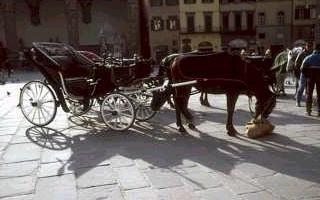
Horse and Buggy in the Main Square
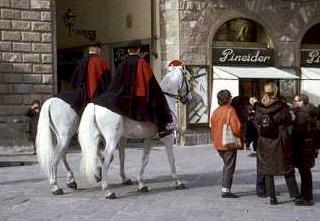
The Main Shopping Street off the Main Square

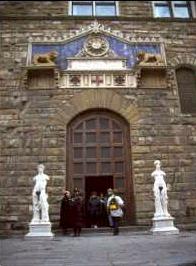
Side Street and Entrance to the Town Hall
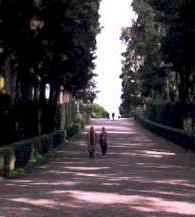
Boboli Garden Viale 
Villa Medicee II
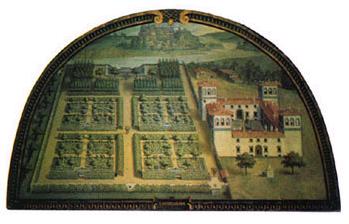
Villa dell'Ambrogiana
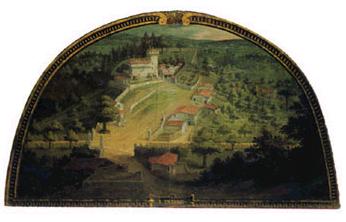
Villa del Trebbio
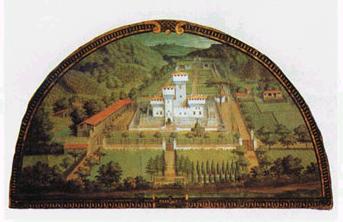
Villa Cafaggiolo
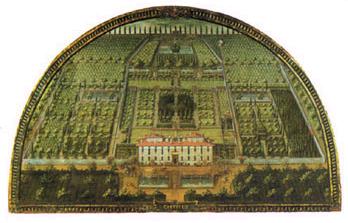
Villa di Castello
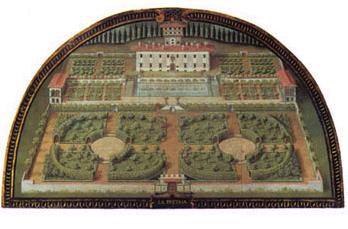
Villa La Petraia

Villa Medicee I

A View of Florence, Approaching from the Hills
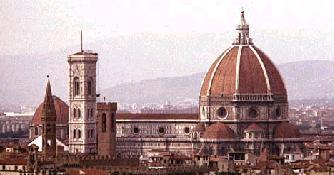
Florence's Cathedral

Arno River and the 'Ponte Vecchio'
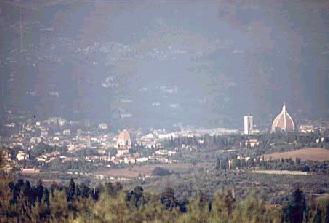
View Leaving Florence for the Hills Beyond
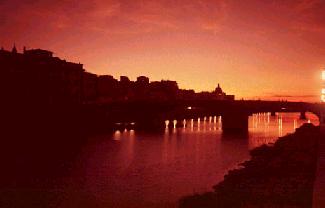
A Sunset Over the Arno River near Florence
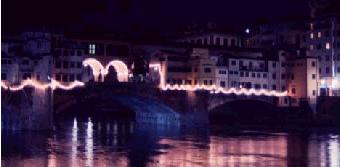
The Old Bridge, Il Ponte Vecchio, Lit at Night
Visit my Italian History pages
|
The Grand Duke and Duchess of Tuscany: Cosimo de' Medici
and Eleonora di Toledo
Palleschi, de' Medici supporters named for the balls (palle) on the de'
Medici coat-of-arms, clearly did not want Lorenzaccio to become Duke of
Florence.
They picked the elder Lorenzo de' Medici's
great-great-grandson, Cosimo di' Medici for the job. Cosimo
was the son of the
mercenary Giovanni delle Bande Nere (also known as Lodovico de' Medici)
a highly respected mercenary leader killed defending Rome from attack.
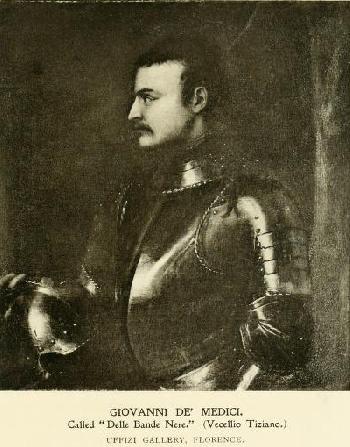
Cosimo's Father, Giovanni
Cosimo was next
in line after Lorenzaccio, and only 18 years old. The Palleschi argued
that since Cosimo's father had married the elder Cosimo
de' Medici's great-great-granddaughter, Maria Salviati, thus rejoining
the senior and junior lines of the de' Medici family tree, it
meant that Cosimo had
greater claim to the title than his evil cousin.
They also liked
that Cosimo was only 18 and had been reared in the countryside,
presumable leaving him politically unaware and easily manipulated.
They hoped
to make him a figurehead leader while they re-established the republic.
Ambitious Cosimo agreed with their logic about his greater claim
to the title. But the Palleschi were wrong about Cosimo being politically
naive.
Cosimo turned on them, refused to marry one of their daughters,
and began gathering all the strings of power into his control.
They turned on Cosimo and raised armies to oust him. But he
defeated the forces, clearly inheriting his warrior father's military
skills.
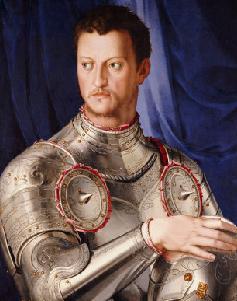

Portrait of Duke Cosimo I de Medici Florence (1503-1572).
This is a much copied official portrait used as the
master-copy for all official copies for public distribution. This
is the approved image Cosimo wanted spread of himself: in his battle
armor, with delicate hands (not true), with the thoughtful expression of
an intellectual (he was smart, but not an intellectual). It also
seems he had Bronzino, the artist, make his jaw softer than
the heavy, square jaw Cosimo really had. He probably looked more
like this bust of him by Bandinelli, like a boxer.
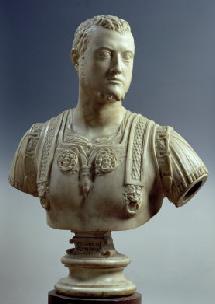

Cosimo I De' Medici 1543
Cosimo proceeded to:
- make himself dictator of
Florence,
- and expand his territory to include all of Tuscany.
- He
astutely strengthened the judiciary,
- funded public works,
- protected the
poor,
- and set up a standing army so he didn't have to rely on
mercenaries (oddly enough, his father was a famous mercenary who
frequently changed sides, perhaps teaching his son
a valuable lesson).
And since he was a de' Medici,
it's been said that he also gave a standing order to
his emissaries to the other courts to assassinate all of Filippo Strozzi's relations whenever the opportunity
presented it. Italy is the home of the vendetta, after all.
Later, as
Cosimo became more concerned with gaining a Grand Duchy status for
Tuscany, he tried to clean up the family's act, and denied any such
order, and any knowledge of poisons, with great disingenuousness.
Interestingly, Cosimo commissioned a census
of Florence in 1461. It showed that there were:
- 60,000 people
living within the walls of Florence,
- 2172 workshops,
- 8741 homes.
This was a severe decline from 30 or so years earlier under the
Florentine Republic. The struggle for independence had cost the
city dearly.
Cosimo worked to increase Florence's wealth and
prestige, including encouraging institutions of higher education, which
pleased people, but he was very careful to keep power in his hands.
He did the same throughout his territories.
Cosimo, like his cousin Alessandro before him,
eventually disposed of the legitimate heir, Lorenzaccio, by sending his
hit-men, yes, he had hit-men on staff, to kill him. They took 12
years to fulfill the contract, but it was done.
Cosimo also
ordered that Alessandro's children with the daughter of Charles V be
disinherited, which they were, the son dying soon after, a bit too
conveniently for some, and Charles V agreed with it for political
reasons.
But Cosimo took in Alessandro's two illegitimate
children, Giulia and Giulio, and brought them up with his own.
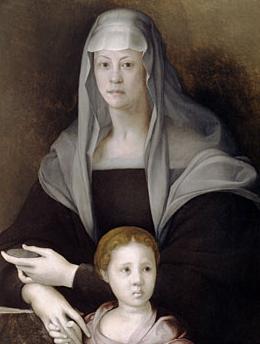
This is a portrait of
Cosimo's mother, Maria Salviati (from the senior de' Medici line), and
Giulia de' Medici, Alessandro's daughter, probably painted in 1542, a
year before the death of Maria at the age of 44
Cosimo officially became Duke
of Florence in 1537. During his reign, Cosimo:
- stabilized the
political position of Florence by conquering all the neighboring cities,
- restored the de' Medici family to wealth and power,
- was patron to all
the top artists and architects of the late Renaissance.
- He took
possession by force of all of Tuscany,
- and formed
in 1569, with the support of the Emperor Massimiliano II and Pope Pius
V, the territory into a Grand Duchy, making himself the first Grand Duke of
Florence.
In essence, Cosimo set up a police state and he was the despot who ruled
it. His life was always in danger, but he made a big show of
walking about the town with his guard. What only a few knew was
that he wore armor under his clothes to protect himself from knife
attacks. Public Relations was in the blood.
(I wonder if
Regan's advisors knew this story when they had him wear long-woolen
underwear under his clothes in Iceland for a summit with Gorbachov, so
he could walk around in just a suit in the freezing cold, looking butch
and tough, and younger than his years? Who knows?)
Villa di Castello is one of the oldest de' Medici villas, in the
family since 1477, with decorations by Botticelli: the 'Primavera'
and the 'Birth of Venus' (now in The Uffizi Galleries).
It was the favorite country estate of Cosimo I
for good reason, it was where he had grown up under the care of his
mother Maria Salviati. She had kept her young son far from the
political intrigues of Florence.
When he took over the family in
1537, Cosimo had Vasari, his favorite architect, rebuilt the Villa, and
Trebbio was hired to create the classic Italian gardens, the first of
their kind. The successors of the de' Medici donated it to the
state in 1919. The gardens are now open to the public.
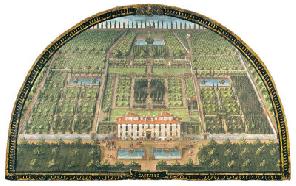

Villa Di Castello
While still a bachelor, Cosimo fathered a daughter, Bia. Bronzino was Cosimo's favorite painter, although he
tormented Bronzino by never naming him the official court painter.
Bronzino painted portraits all of Cosimo's family, including this one of Bia. Bia died aged 5, about the age in this portrait.
In Bia's portrait, she
wears a medallion with the profile of Cosimo on it.
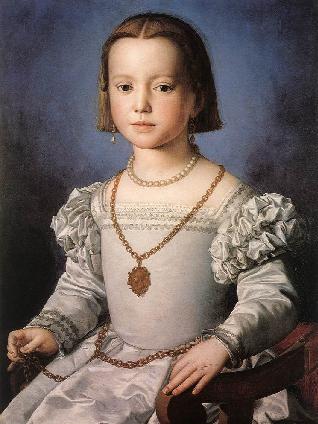
BRONZINO, Agnolo
Bia, Daughter of Cosimo I de' Medici
c. 1542
Cosimo knew he needed legitimacy to rule safely, and he needed class to
turn his rough, earthy de' Medici family into the great royal House he
hoped for. He asked first to marry Alessandro's widow, daughter of
Charles V. But Charles V had already promised her to someone else.
Charles V offered to intervene with the King of Naples to get the hand
of his eldest daughter for Cosimo. But Cosimo knew he could never
love the girl, and was instead very attracted to the youngest daughter,
Eleonora, beautiful, intelligent, and fun-loving.
Eleonora was
used to the Spanish court's young men, so the battle-hard, virile,
handsome, ambitious Cosimo who desired her over her sister, was probably
a hunky catch in her eyes.
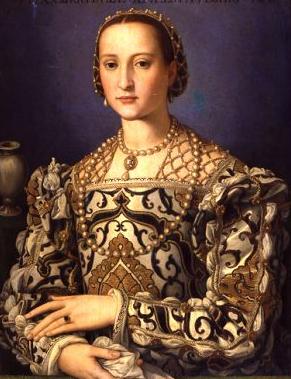
This painting was made from the one that appears below, when she was 23.
So
Cosimo married Eleonora di Toledo, the beautiful and rich 17-year-old daughter of the viceroy of Naples Don Pedro di
Toledo, in 1539, and they to all accounts had a good marriage,
the early years full of love, laughter, travels together.
Eleonora gave birth to 7 sons and 4 daughters, approximately one child each
year of their first 11 years of marriage.
Cosimo also garnered with the marriage, peace with the Spanish who
controlled southern Italy, and an army which he used to further
consolidate his power through vicious warfare.
Eleonora influenced her husband in many ways, such as encouraging his
support of the new order of Jesuits, and in providing a haven for Jews
in an Italy that was becoming increasingly inhospitable due to bigoted
laws passed by the Vatican in their misguided counter-reformation.
Cosimo and his wife led a peripatetic life, traveling between palaces and estates for
the various seasons, for vacations, for hunting and fishing, for their
health, and for safety. Eleonora:
- managed the vast staffs of all
the households, making sure that all that was needed with each move was
where it was supposed to be.
- She also ordered special fabrics,
makeup, specialist household goods, and gift items from all over Italy,
- and gifts sent all over Europe to ruling families.
- And she managed
the care, amusements and education of her children, in the early years
with the help of her mother-in-law Maria Salviati.
- she sourced specialty items from all over Italy and from the New
World for their court.
Documents show that they were a normal husband and wife in surprising ways.
For example, when Eleonora was especially pleased with a pair of new red
velour shoes, her husband joked that with the addition of a gold cross
embroidered on them, they would be fit for the Pope. Women and
shoes and their envious husbands...time never changes human nature.
The military adventures, many children, vast estates and patronizing
artists cost money. It's known that when necessary, the family is
pawned their jewels with Florentine bankers to increase their cash flow.
The jewels were made to be easily removed from their settings to give to
pawn-brokers, and to move between settings to replace those pawned.
Pragmatic is probably the best word to describe Cosimo and his new House
of Medici.
This later portrait of Eleonora by the same artist, Bronzino,
shows a woman past the bloom of youth, yet still beautiful, if not
sadder. She would have already contracted syphilis from her
husband, who suffered from it most of his life.
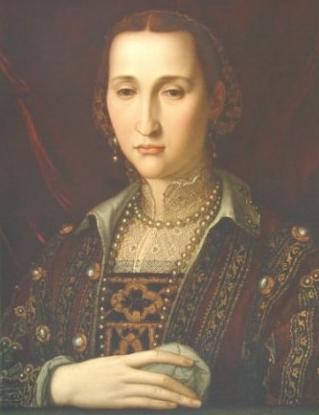
The Palazzo Medici remained in possession of Alessandro's widow, as per
an agreement with Charles V, so Cosimo took possession of the Palazzo Vecchio (Cosimo called it
Palazzo Maggiore) in
1540 as
his family home, becoming the Palazzo Ducale.
He had it redesigned
and decorated with frescos by Vasari of the
de' Medici family. Below is Palazzo Vecchio, also called Palazzo Vecchio.
Below that is a view of the entrance to the Palazzo Vecchio and the Uffizi to the right of it.

This is a view
of the interior court of the Palazzo decorated by Vasari for Cosimo de'
Medici. Vasari also supervised the vast decoration of the Salone
dei Cincquecento and the Sala di Cosimo Il Vecchio with scenes
commemorating great moments in de' Medici family history.
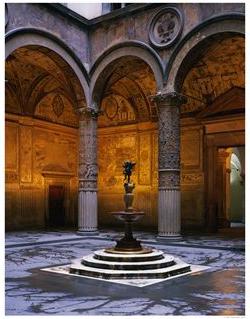

Patio Interior in Palazzo Vecchio
Vasari, Giorgio
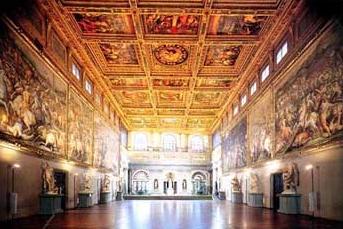
The Salone dei Cincquecento, the ministerial and representative meeting
hall, and court reception hall during Cosimo's time, decorated in his
glory by Vasari, by order of Cosimo.
From the wonderful Wikipedia
page on Il
Palazzo Vecchio:
"On the walls are large and expansive frescoes that
depict battles and military successes of Florence over
Pisa and
Siena :
- "The taking of Sienna",
- "The Conquest of Porto Ercole",
- "The victory of Cosimo I at Marciano in Val di
Chiana",
- "Defeat of the Pisans at the Tower of San
Vincenzo",
- "Maximillian of Austria attempts the conquest of
Leghorn",
- "Pisa attacked by the Florentine Troops"
The ceiling consists of 39 panels also constructed
and painted by Vasari and his assistants, representing
"Great episodes from the life of Cosimo I", the
quarters of the city and the city itself and towards the
center is the
apotheosis : "Scene of his glorification as Grand
Duke of Florence and Tuscany""
Visitors to Florence know Gli Uffizi, the main museum of Florence.
It was built by order of Cosimo in 1550 to hold the city administration
(Gli
Uffizi means The
Offices) and his court in one convenient and central building rather than
in smaller offices all over the
city.
A district of homes and businesses that flanked the river
was torn down to make room for the two long Uffizi buildings and joining
end piece that faced the river.
A few years back, when they
repaved the main square, they discovered under the square the old dye
pits used by the fabric dyers who had once lived in that area of the
city.
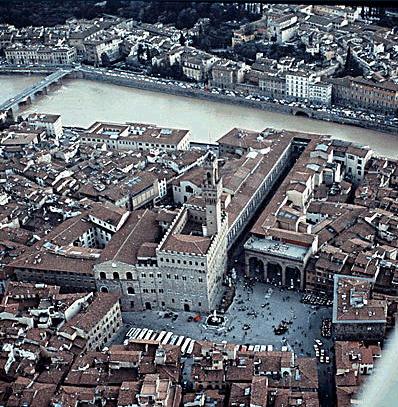
Also in 1550, Eleonora purchased Palazzo Pitti from the Pitti family
(she was very wealthy in her own right, owning estates in Spain) and
made it their new home. They developed further the estate behind
the Palace and the Palace itself to accommodate their growing family.
Below is a depiction of the Palace at that time with the estate behind.
Below that is how it appears today.
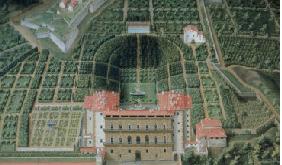

Fort Belvedere and The Pitti Palace from a Series of Lunettes Depicting Views of The Medici Villas
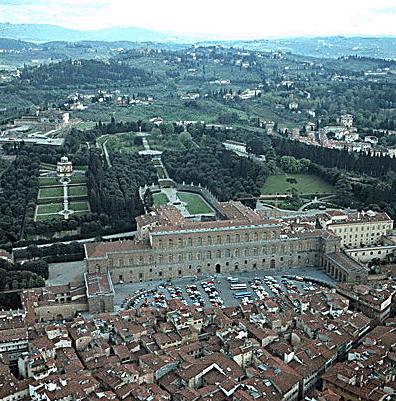
Palazzo Pitti and the Boboli Gardens today. Click
here for
more about both.
Cosimo made sure
his subjects were entertained and fed in the Roman tradition of keeping
civil peace by providing the public with Bread and Circuses, food and
entertainment.
Like the earliest de' Medici Cosimo, the Elder,
religious festivities were underwritten by the de' Medici, and secular
fun was encouraged, with the de' Medici usually offering the prizes for
the winning parties.
There were also massive parties for occasions
having to do with the de' Medici family itself:
- weddings,
- arrivals
of important guests,
- anniversaries,
- military successes, for example.
Here are
two images of secular celebrations in Florence in 1555, during Grand
Duke Cosimo's time, by an artist who in Italy is known as
Giovanni Stradano: a football (Calcio
Storico) tournament, and a jousting tournament.
Certain areas
of Florence (Fiorenza) were off-limits to footballers, while others were
adjusted to allow the local boys to play to their hearts content, like
Piazza Santa Croce, where today's Calcio Storico celebratory game is
played each year.
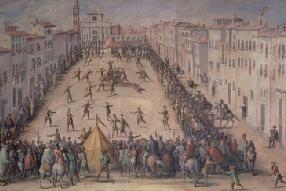

A Game of Football in The Piazza Santa Maria Novella, Florence, 1555
The later years were less kind to the couple. They both suffered
from ill health, the most likely cause is syphilis, passed from
Cosimo to Eleonora.
By the time
Eleonora was 40, she had buried 5 of her children. She suffered twisted legs
because the syphilis had progressed to its
advanced phase causing shin splints. She also had hairline fractures
on her pelvic bone due to her many pregnancies and deliveries (she was a
small woman - only 5 feet tall, complicating deliveries).
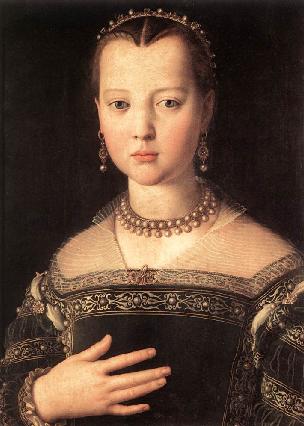
BRONZINO, Agnolo
Portrait of Maria Lucrezia de' Medici
1551 (Eleonora's first born in 1540, age 11 in this portrait, she died
at age 17)
It was always believed that Eleonora had TB, diagnosed from her pale
skin, thin build and long fingers and hands. But the pale skin
could well have been from makeup she's known to have used. Her
thinness was likely from the syphilis.
This portrait by the
same artist as before, Brozino, is from 1560. Eleonora is aged 38,
and shows the wear her life had on her.
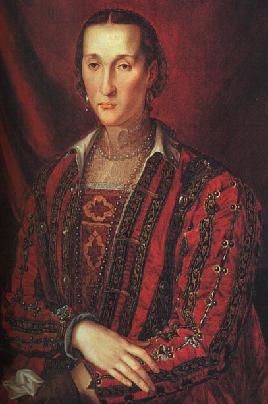
In 1562,
Eleonora traveled with her 15 year old son Garzia, to visit his 19 year
old brother, Giovanni, a Cardinal in Pisa. Cardinal Giovanni
warned against the trip because of an outbreak of malaria in the swampy
region.

Cardinal Giovanni de' Medici
During the trip, Garzia died of malaria, Giovanni died of it soon
after,
and Eleonora contracted and died of it too, not long after that. Eleonora was buried in the gown she wears in
the first portrait of her on this page, believed to be her wedding gown.
Bronzino painted several charming portraits of Giovanni and Garzia as
children.
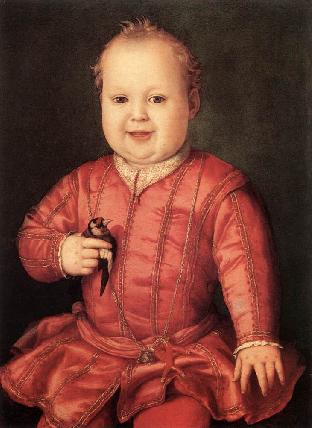
BRONZINO, Agnolo
Portrait of Giovanni de' Medici
c. 1549
Some people spread rumors that one brother had killed the other who was then
killed by Cosimo, and that Eleonora died of a broken heart. But recent
forensic evidence proves that malaria was the killer for all three.
Cosimo is the one who suffered the broken heart. He had ignored
his son's warnings about the malaria. Cosimo was suffering bad
health too, from hereditary arthritis and from syphilis.
In 1564, he turned over power to his son Francesco.
In 1565
Cosimo had Vasari build a corridor from the government offices to the
Palazzo Pitti, so he and his family could walk in safety from home to
work and back. It's called the Vasari Corridor and can be seen on
the left side over the arcade in the image below, with The Uffizi in the
middle above the larger arches.

The Corridor passes over the Old Bridge as seen in this image. It
continues on through a church and ends in the gardens of Boboli behind
the Palazzo Pitti.
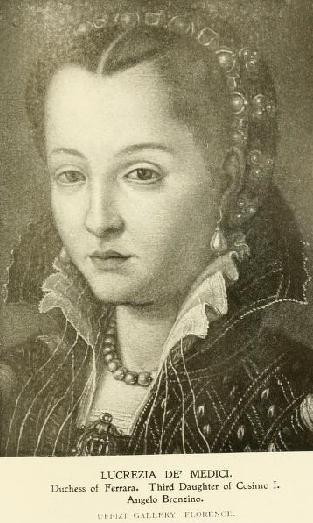
Remember murdered Alessandro's two illegitimate children, Giulia
(2 years old at the time of her father's death) and Giulio (4 years old)?
They went on to make
Alessandro's royal line live longer than any other de' Medici.
They linked via marriage the de' Medici line with the royal
houses of the:
- Hapsburgs,
- the Bonaparte line,
- the Belgian royal family
- and many Italian royal families.
Cosimo arranged Giulia's first marriage to a
de' Medici cousin. He died soon after, but she was happy.
She was now
legally a de' Medici by name. She later married into the Spanish
court in Naples.
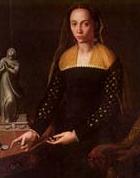
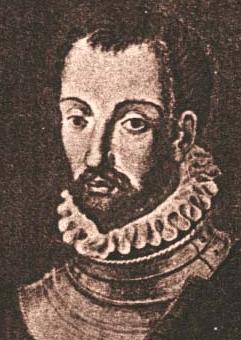
Giulia and Giulio de' Medici
Cosimo was also instrumental in gaining another de' Medici pope, by sending
his cousin, Alessandro Ottaviano de' Medici (1535-1605), an ordained
priest, as his representative to the Vatican.
This put Alessandro Ottaviano before
the eyes of three Popes who rewarded him for his service and competence
with promotions to Bishop and Cardinal, and special missions for the Popes.
In 1605, when Alessandro was 70 years old, he was elected Pope to spite
the French and Spanish. Unfortunately, he became ill immediately,
and died within 26 days of taking the office. He was a very ill
Pope from April 1, 1605 to April 27, 1605. This is his official
Papal image.
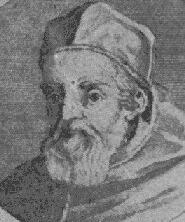
In 1564, Michelangelo died in Rome. Cosimo was notified by a
doctor in attendance that Michelangelo died without family in Rome and
without a will, but that he had told him he wished to be buried in
his beloved Florence.
This excerpt of the message gives an idea of how
Michelangelo was viewed by his contemporaries.
"Questa sera è passato da questa a miglior vita quell'Ecc.mo et
veramente miracol di natura M.r Michel Agnolo Buonarroti."
"This evening passed someone from this life to a better life, that
Most Excellent and truly a miracle of nature, the Most Revered Michel
Agnolo Buonarroti."
Cosimo had the most famous
Florentine artist's body:
- returned to Florence,
- paraded solemnly through the streets for people to
show their respect, and
- entombed in the Church of Santa Croce with high
honors and a memorial.
Just a side note: Da Vince was called 'The Grand Vinci' by
Cosimo's court.
This sort of funeral and burial was unheard of for an artist, but it
was what Michelangelo deserved, and it was paid for by the family
that discovered him, gave him his early education, and financed many of
his greatest works from sculpture, to paintings, to architecture, the
de' Medici.
Cosimo also ordered the Laurentian Library, designed by Michelangelo,
be opened to the public, as it still is today.
In the main square of Florence is an equestrian statue of Cosimo
the
Grand Duke of Tuscany. (Also in the main square at that time was
Michelangelo's 'David'. One arm of 'David' had been damaged in
1527 during the anti-Medici riots that routed them. One of Cosimo's first acts on taking power in Florence was the crowd-pleasing
one of having the arm repaired.)
Even after retirement and suffering various illnesses, Cosimo
managed to find the energy to take two lovers (but rumor has it he
had something of a harem at his villa and took women freely in
Florence throughout his life), father 3 children (two who lived to marry), and marry
his lover, Camilla Martelli.

Camilla de' Medici, Cosimo's second wife
Cosimo retired to his childhood home, Villa di Castello, and died there in
1574.
Here's a link to a book about portraits of Medici women painted
during this period, many by Bronzino. The author analyses the
coded messages contained within the images.
To the next section:
The Age of Discovery, Francesco and Ferdinando: Two Very Different Brothers
|
|

